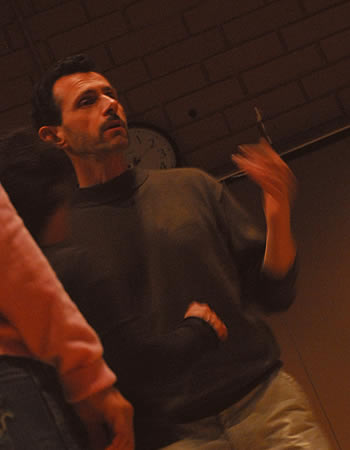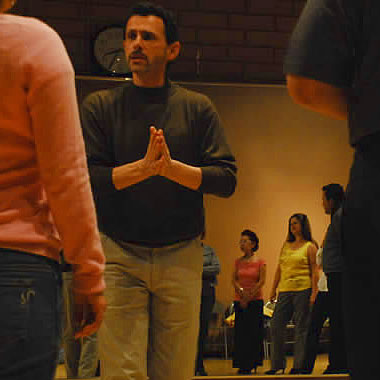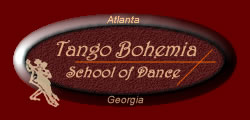Tango Bohemia Founder and Teacher

Ilya started Tango Bohemia School of Dance in 2006 in Atlanta, Georgia. Its mission – to promote a social style of Argentine Tango and to show to his students that it is not all that difficult to learn how to dance. (check out dance testimonials about his teaching style and results students get in a short time)
Currently Ilya teaches Wedding Dance Lessons, conducts dance workshops, and offers private lessons for dancing in general.
What’s so Special about Argentine Tango
– Q: What made you interested in dancing?
Ilya: When growing up in Russia, I always associated music with movement. However, I did not get involved in dancing until much later when I already resided in the US. “Real life” seemed to interfere with my interest: college, job, moving to the US, starting a new life here…
– Q: How long have you been involved in the world of dance?
Ilya: I walked into a Fred Astaire Dance Studio in 1993 after seeing an ad in the local paper. I suddenly knew it was time to follow my long-awaited interest in partner dancing. Vonnie Marie was my first ballroom teacher.
– Q: What dancing experience do you have?
Ilya: 20 years of dance experience and counting – started with a “standard set” of ballroom dances, Smooth (Foxtrot, Waltz, American Tango) and Rhythm (Rumba, Cha-Cha, Bolero, Swing), then added club-style Salsa. I liked all dances, however my focus was mostly on a dance technique. Quality of movement was always important: dancing feels very different when it’s done right. Than came Argentine Tango.
– Q: How were you introduced to Argentine Tango?

Ilya: 10 years after entering the ballroom world I decided to expand my dancing interests. Being curious about Argentine Tango for some time, one Monday in 2003 I joined Tango classes offered at the same studio where I studied with Bob Mitchell (a well-known dance coach from Greenville, SC). It took some time, practice, and persistence.
I attended classes in all the Tango schools in Atlanta (at that time) over several months and chose the one that taught a style I felt reflected the spirit of Tango.
– Q: Why did you choose Milonguero (or Apilado) style?
Ilya: While there are almost as many Tango styles as there are dancers, I recognize several distinguishable styles. One of them is called Milonguero (or Apilado). It is unique because dancers share their axis when they dance. In my opinion Apilado creates the level of connection between partners which does not exist in other Tango styles. While unusual at first, with little practice your dance becomes relaxed, natural, …and addictive :)
– Q: Who were your teachers?
Ilya: When I started with Tango in 2003 I went through several schools in Atlanta and learned about various styles of Tango and different approaches to teaching. Since my preference was Milonguero style, I decided to continue with Barbara Durr (leading) and Magdalena Zigova (following). Barbara loves Tango. She often travels to Buenos Aires to stay current in her dancing skill. I was happy to learn from Barbara the importance of subtlety when dancing Milonguero: small movements may not be seen, yet “speak” volumes to your partner.
Then in May 2006 I attended a workshop conducted by Eric Jorissen at the Denver Tango Festival. At first I was hesitant to go: after all his name did not even sound Argentine; and I’d never heard of him before. Little did I know this one workshop would change not only my stereotypes but my entire way of thinking and understanding ‘everything Tango’.
– Q: Tell us about Eric Jorissen
Ilya: Eric Jorissen is from The Netherlands, not from Buenos Aires. But after the first ten minutes of Eric’s workshop I realized that he understands, feels, and, most importantly, teaches Argentine Tango like no one else I have ever met. His teaching “talked” to me. It matched my own thoughts and views on Tango embrace, connection, movement, and musicality. It turned out Eric was a well-known Tango instructor who studied dance education at the Rotterdam conservatory. His Tango mentor was famous Pepito Avellaneda, one of the best dancers and teachers of Argentine Tango from Buenos Aires, who passed away in 1996. To make a long story short, 2 months after that workshop I flew to The Netherlands, to his Tango school El Corte in the town of Nijmegen, to take part in the International Teacher Week (training course for Tango teachers).
The importance of my training with Eric is hard to overestimate. He has so much talent, knowledge, and dedication to Tango that studying with him is like peeling an onion – every time I find new, important, and yet subtle layers of nuances that help make teaching Tango an inspiration and dancing it an art. And yes, at times one might shed a tear or two, if only because of seeing the bright light of Tango :)
– Q: How did you make a transition to teaching?

Ilya: I started teaching Argentine Tango in Atlanta, Georgia in 2006.
I wanted to share with others my vision of Argentine Tango based on years of experience in studying dance movement.
The greatest reward for me is when I see a spark in my students’ eyes and a smile on their faces in a class. My goal is more Tango “sparks and smiles” in my students.
– Q: Do you still have to challenge yourself in Tango?
Ilya: It is not that I Have to challenge myself, I Want to challenge myself. Argentine Tango is a process, not a destination. The moment we stop learning and practicing, we begin to lose our skill. For me a continuing education as a teacher is even more important than as a dancer. I attend many workshops with visiting instructors in Atlanta and other cities. I travel to Denver, New York, and Houston, to take workshops and dance at Tango Festivals. Most importantly I have studied with Eric every year since 2006.
– Q: Is there a dancer who inspires you the most?
Ilya: I would have to say it is Carlos Gavito along with Eric Jorissen. When I watch their videos I see passion, technique, great musicality. Their dancing is natural and organic, just the way I see Tango. Unfortunately there are not many videos of Eric dancing, but even those few offer a lot of material for study and personal improvement.
– Q:What is more important in Tango, passion or technique?
Ilya: When we dance we feel and follow the passion of Tango music. A technique alone cannot create this feeling. Sure, it can enable a person to dance, but it’s not enough. Only passion coupled with technique can make Argentine Tango come alive on the dance floor.
– Q: What influence has Tango had on your life?
Ilya: Tango to me is like another world, just a bit smaller. Entering this world can make us feel deeper, know more, communicate better, and experience and enjoy life to the fullest. What more can we ask for from a dance? Argentine Tango offers anything and everything to a person interested in dancing: beautiful music, variety of dances (tango, vals, milonga, canyenge, and candombe), milongas in Atlanta and outside (Tango dance parties), nice community of tango aficionados, Tango festivals in the US and abroad, and an “excuse” to visit Buenos Aires, Argentina.
